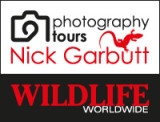Photography Top Tips and Ideas
Here are a few quick tips that will help you improve. Try to bear them in mind whenever you head out with your camera. Many of the concepts are expanded upon in the more detailed accounts relating to Safari Photography, Rainforest Photography etc.
I hope these will give some guidance and appropriate advice if you are just starting out in wildlife photography or perhaps are already experienced but would like to take things further.
Top Tips for Taking Better Wildlife Photos
- Familiarise yourself with your camera before any trip. Don’t buy a new model before a trip and then open the manual for the first time when you arrive.
- As much as possible use a tripod or similar camera support, such as a bean-bag when photographing from a vehicle to achieve sharp results.
- Make the most of the equipment you currently own and explore its capabilities to the full. Too many photographers get preoccupied with getting the 'next bit of kit', as if this will automatically improve their photography. I have certainly been guilty of this, especially early on in my career.
- Always use an animals’ head and especially its eye as the point to focus upon.
- Try to photograph animals from their eye level (or below) as the perspective is much more engaging. Animals photographed from an angle that looks downward, foreshortens perspective and often looks ‘dominating’.
- Where possible always pay as much attention to the background as the main subject. Distracting backgrounds can ruin otherwise good photos and sometimes simple and subtle camera repositioning can make all the difference.
- Allow a subject space to breathe in the frame. Don’t always assume tightly cropped close-ups are the best bet. Instead show the subject in the context of its environment.
- Don’t forget to turn the camera round into portrait (vertical) orientation when photographing subjects that lend themselves to this aspect.
- Don’t assume sunny conditions are good for photography. Most of the time they are not. Concentrate your efforts when the sun is low and near the horizon. In the middle of the day direct sunlight is blue and harsh, washing out colours. In the middle of the day cloudy conditions are best, especially for showing accurate colours and detail.
- When taking close-ups or macro shots use manual focus, then zoom in on your subject using the camera’s live view feature to check the focus is pin-point and exactly where you want. Many DSLR’s give you the option to zoom into x5 or x10 in live view.
- Use a small piece of aluminium foil or silver backed card from inside some fruit juice cartons or the reflective card from packs of smoked salmon as a reflector. These are perfect for bouncing subtle light into tight spots and reducing shadows allowing more detail to be shown. And they are cheap.

Always use a tripod or similar camera support © Alex Hyde

Southern Lapwings displaying. Here I was lying on the ground to get an eye-level perspective. And I shifted position to avoid seeing fence posts in the background. The out-of-focus pale areas behind the birds' heads are still annoying.

Bornean Horned Frog. Cloudy conditions produced soft, diffuse light and a small reflector was used to throw a subtle trace of light onto the frog's underside.

